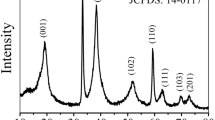Abstract
The present investigation describes the synthesis of uniform sponge-like Ni(OH)2 nanoparticles on stainless steel substrates by a two-step successive ionic layer adsorption and reaction method; the study also explores electrochemical properties. The formation of the β-phase Ni(OH)2 and it’s nanocrystallinity are confirmed by X-ray diffraction and X-ray photoelectron spectroscopy studies. Scanning electron microscopy revealed the formation and random distributions of porous and sponge-like nanoparticles with high Brunauer–Emmett–Teller surface area of 56.4 m2 g−1. The maximum specific capacitance of 428 F g−1 was obtained at 5 mV s−1 in a 2 M KOH electrolyte, indicating promising supercapacitor applications with remarkable rate capability. These results suggest the importance of rational design and synthesis of thin nanomaterials for high-performance energy applications.




Similar content being viewed by others
References
Miller JR, Simon P (2008) Science 321(651):652
Simon P, Gogotsi Y (2008) Nat Mater 7:845–854
Lokhande CD, Dubal DP, Joo O-S (2011) Curr Appl Phys 11:255–270
Liu C, Li F, Ma LP, Cheng HM (2010) Adv Mater 22:E28–E62
Wang X, Luo H, Parkhutik PV, Millan A, Matveeva E (2003) J Power Sources 115:153–160
Chen J, Bradhurst DH, Dou SX, Liu HK (1999) J Electrochem Soc 146:3606–3612
Berkat L, Cattin L, Reguigui A, Benede CJ (2005) Mater Chem Phys 89:11–20
Sillen AF, Martell (eds) (1971) Stability constants of metal ion complexes, Suppl 1. The Chemical Society, London (special publication no. 25)
Xiang L, Yin YP, Jin Y (2004) J Solid State Chem 117:1535–1541
Cao L, Lu M, Li HL (2005) J Electrochem Soc 152:A871–A875
Dubal DP, Dhawale DS, Salunkhe RR, Lokhande CD (2010) J Electroanal Chem 647:60–65
Dubal DP, Dhawale DS, Salunkhe RR, Lokhande CD (2010) J Alloys Compd 496:370–375
Kulkarni SB, Jamadade VS, Dhawale DS, Lokhande CD (2009) Appl Surf Sci 255:8390–8394
Patil UM, Gurav KV, Fulari VJ, Lokhande CD, Joo OS (2009) J Power Sources 188:338–342
Kandalkar SG, Lee HM, Seo SH, Lee K, Kim CK (2011) J Mater Sci 46:2977–2981
Deshmukh PR, Pusawale SN, Jagadale AD, Lokhande CD (2011) J Mater Sci. doi:10.1007/s10853-011-5946-1
Acknowledgements
This research was supported by Basic Science Research Program through the National Research Foundation of Korea (NRF) funded by the Ministry of Education, Science and Technology (No. R15-2008-006-03002-0). One of the authors Dr. D. P. Dubal acknowledges to the support from the BK-21 Program.
Author information
Authors and Affiliations
Corresponding author
Rights and permissions
About this article
Cite this article
Dubal, D.P., Lee, S.H. & Kim, W.B. Sponge-like β-Ni(OH)2 nanoparticles: synthesis, characterization and electrochemical properties. J Mater Sci 47, 3817–3821 (2012). https://doi.org/10.1007/s10853-011-6236-7
Received:
Accepted:
Published:
Issue Date:
DOI: https://doi.org/10.1007/s10853-011-6236-7




